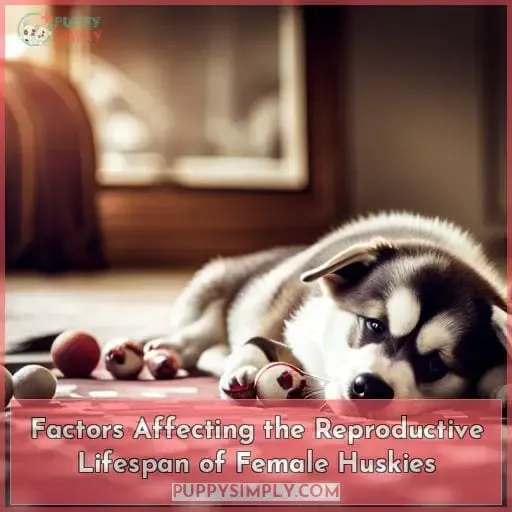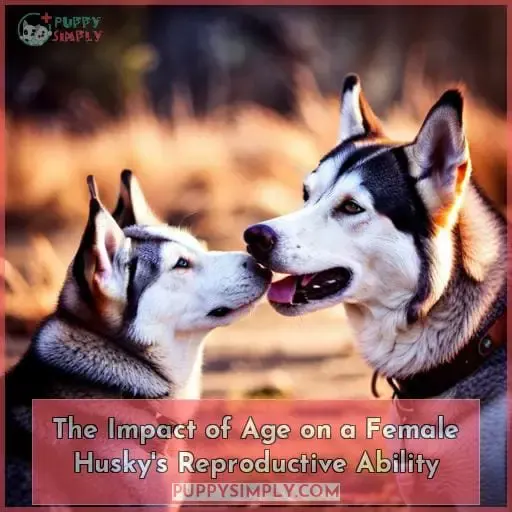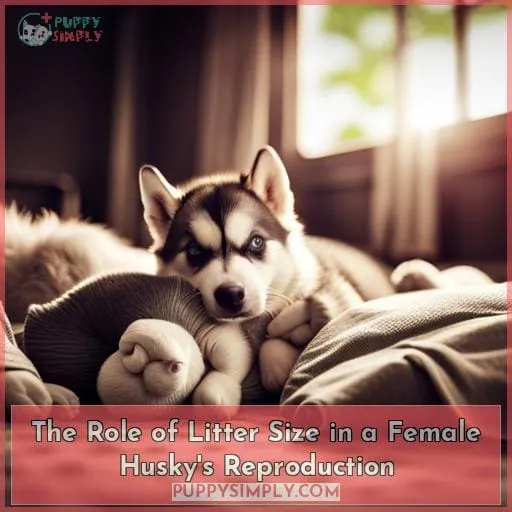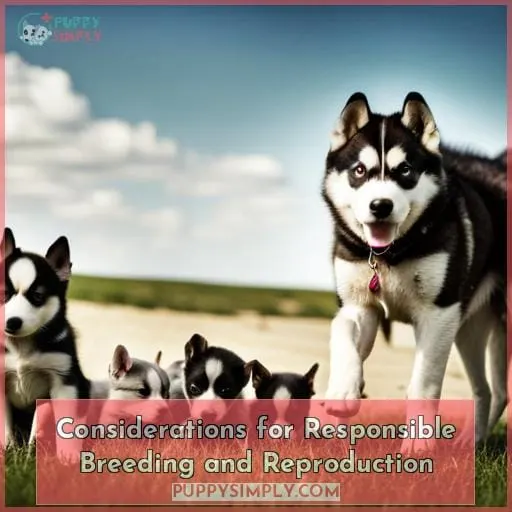This site is supported by our readers. We may earn a commission, at no cost to you, if you purchase through links.
 Imagine the joy of raising a litter of adorable husky puppies. But how long can this reproductive journey last for your beloved husky? Factors like nutrition, genetics, breeding practices, and age play crucial roles in determining their lifespan of reproduction.
Imagine the joy of raising a litter of adorable husky puppies. But how long can this reproductive journey last for your beloved husky? Factors like nutrition, genetics, breeding practices, and age play crucial roles in determining their lifespan of reproduction.
In this article, we will explore these factors and provide valuable insights into the average reproductive lifespan of female huskies.
Table Of Contents
- Key Takeaways
- Factors Affecting the Reproductive Lifespan of Female Huskies
- The Impact of Age on a Female Husky’s Reproductive Ability
- The Role of Litter Size in a Female Husky’s Reproduction
- Average Lifespan of Reproduction for Female Huskies
- Considerations for Responsible Breeding and Reproduction
- Frequently Asked Questions (FAQs)
- How can I determine the size and weight of my Husky as it grows?
- What factors contribute to the color of a Husky’s eyes?
- Why does my female Husky sometimes appear skinny despite being fed well?
- Are Huskies known for growing rapidly in their first year?
- How can I ensure my Husky is in optimal health for breeding?
- Conclusion
Key Takeaways
- Nutrition, genetics, breeding practices, and the age of breeding start all play a role in the reproductive lifespan of female Huskies.
- The impact of age on a female Husky’s reproductive ability includes factors such as pregnancy and birth health, recovery and postpartum care, and long-term health and well-being.
- The role of litter size in a female Husky’s reproduction involves considering the recommended time between litters and the impact on the mother’s health.
- The average lifespan of reproduction for female Huskies depends on the age range for reproduction and the length of each reproductive cycle.
Factors Affecting the Reproductive Lifespan of Female Huskies
Feeding and nutrition play a crucial role in determining the reproductive lifespan of female Huskies.
Providing your dog with high-quality food can extend her ability to reproduce for a longer period of time.
Genetics and lineage also influence how long a female can reproduce, as getting your bitch from a good lineage increases her chances of having healthy offspring.
Additionally, breeding practices such as not overbreeding and starting at an appropriate age are important factors that affect the reproductive lifespan of female Huskies.
Feeding and Nutrition
To ensure the optimal reproductive lifespan of your female Husky, provide her with high-quality food and nutrition.
Feeding your dog a balanced diet will support her overall health and reproductive function.
Additionally, obtaining a Husky from a good lineage can contribute to their longevity as breeders.
It’s important not to overbreed or start breeding too young in order to avoid negative impacts on their reproductive ability.
Taking breeding seriously includes considering factors such as husky lifespan, age to breed, and litter size for the well-being of both mother and puppies.
Genetics and Lineage
If you want to understand how genetics and lineage play a role in the reproductive lifespan of female Huskies, consider the impact they’ve on factors such as fertility and overall health.
Good lineage contributes to healthy puppies by reducing the risk of genetic disorders.
Responsible breeding practices also focus on selecting dogs with good health, ensuring that potential mothers are free from hereditary issues that could affect their ability to reproduce successfully.
By prioritizing genetics and lineage, breeders can increase the chances of producing strong and thriving litters.
Breeding Practices
When breeding female Huskies, the number of litters they’ve had and the interval between pregnancies play a crucial role in determining their reproductive lifespan.
Spaying or neutering your Husky at an early age can help prevent health complications and extend their ability to reproduce.
Overbreeding should be avoided, as it can negatively impact the mother’s health.
It’s recommended to wait 18 months between each pregnancy to ensure optimal well-being for both the mother and her puppies.
Age of Breeding Start
You can maximize the reproductive lifespan of your female Husky by considering the age at which you start breeding her.
It’s recommended to wait until she’s at least 2 years old before allowing her to breed.
Breeding a Husky too young, such as at 8 months or 1 year old, can have negative consequences on her health and ability to handle pregnancy.
Waiting until she reaches 18 months or even 2 years will ensure that she’s physically mature and better equipped for reproduction.
The Impact of Age on a Female Husky’s Reproductive Ability
As a female Husky ages, her reproductive ability may be impacted in various ways.
Pregnancy and birth health can be affected, with older females potentially experiencing more complications or difficulties during the process.
Recovery and postpartum care also become increasingly important for older females to ensure their well-being after giving birth.
Additionally, long-term health considerations should be taken into account as the age of a female Husky advances to maintain her overall reproductive ability for as long as possible.
Pregnancy and Birth Health
During pregnancy and birth, a female Husky’s age plays a significant role in determining her reproductive ability and overall health.
- Eclampsia
- Placental problems
- Neonatal isoerythrolysis
- Vaginal discharge
Older females are more susceptible to these issues compared to younger ones. It’s important to monitor the health of a pregnant Husky closely and provide proper veterinary care throughout the process to ensure successful reproduction and minimize any potential risks or complications.
Recovery and Postpartum Care
After giving birth, it’s important for a female Husky to receive proper care and support during her recovery period.
- Administering pain medication if necessary
- Monitoring blood loss to ensure there are no complications
- Preventing infection through regular cleaning and hygiene practices
- Assisting with weight loss through controlled diet and exercise
- Providing lactation support to promote healthy nursing of the puppies
Adequate postpartum care plays a crucial role in ensuring the mother’s well-being after childbirth.
Long-Term Health and Well-being
As she ages, a female Husky’s long-term health and well-being can significantly impact her reproductive ability.
Factors that influence her reproductive health include:
- an increased risk of pyometra
- uterine cancer
- hip dysplasia
as she gets older. However, there’s evidence to suggest that aging may decrease the risk of mammary cancer and ovarian cancer in female Huskies.
It’s crucial to prioritize the overall well-being of your Husky throughout their lifespan for optimal reproductive function.
The Role of Litter Size in a Female Husky’s Reproduction
When discussing the role of litter size in a female Husky’s reproduction, it’s important to consider the recommended time between litters and its impact on the mother’s health.
Waiting 18 months between pregnancies is often advised to ensure better maternal health. This allows for proper recovery and reduces potential complications associated with frequent breeding.
Recommended Time Between Litters
To ensure the health and well-being of a female Husky, it’s important to consider the recommended time between litters as this directly impacts her reproductive ability.
It’s generally advised to wait at least 18 months between each pregnancy in order to allow for proper recovery and minimize potential health risks. This ensures that the mother has enough time for nursing (6 months) and weaning (8 weeks), while also considering her average lifespan of 1 year for optimal breeding practices.
| Recommended Time Between Litters |
|---|
| Minimum Wait Time: 18 Months |
| Maximum Number of Litters/Year: 2 |
| Nursing Period: 6 Months |
| Weaning Period: 8 Weeks |
Impact on the Mother’s Health
By limiting the size and frequency of litters, you can significantly improve the overall health and well-being of your female Husky during her reproductive lifespan.
- Risk of complications: Decreasing litter size reduces the risk of complications during pregnancy and birth, such as dystocia or uterine infections.
- Increased chance of death: Large litters can strain a mother’s resources, increasing her chances of maternal death.
- Shorter lifespan: Overbreeding with large litters can lead to chronic health issues that may shorten a female Husky’s lifespan.
Average Lifespan of Reproduction for Female Huskies
Female Huskies have a reproductive lifespan that typically lasts for 7 years, starting at around 2 years old and ending around 9 years old. However, it’s important to note that the beginning age of reproduction can greatly impact how long a female can continue to reproduce.
Starting at an older age may result in better pregnancy outcomes and overall health for the mother.
Age Range for Reproduction
You can expect female Huskies to reproduce from around 2 years old until approximately 9 years old, with an average reproductive lifespan of seven years.
Starting at an ideal age is crucial for the health and well-being of both the mother and her offspring. While early reproduction poses risks such as stunted growth and developmental issues, late reproduction presents challenges like reduced fertility rates.
By starting at the right age, you can ensure extended fertility benefits for your female Husky.
| Age Range (Years) | Reproductive Lifespan (Years) |
|---|---|
| 2 – 9 | ~7 |
Length of Each Reproductive Cycle
During each reproductive cycle, a female Husky can typically reproduce for an average lifespan of 7 years.
The length of the heat cycle in a female Husky is approximately 21 days, with the estrus period lasting around 9 days.
Following ovulation, there’s a diestrus period that lasts around 60-90 days if pregnancy doesn’t occur.
Considerations for Responsible Breeding and Reproduction
When considering responsible breeding and reproduction of Huskies, there are several important factors to keep in mind.
- Health testing and screening should be prioritized to ensure the overall well-being of both the parents and their offspring.
- Ethical breeding practices, such as not overbreeding or starting too young, can help maintain the longevity of a female Husky’s reproductive years.
- Additionally, responsible placement of puppies is crucial for finding them good homes where they’ll receive proper care and attention throughout their lives.
Health Testing and Screening
To ensure responsible breeding and reproduction, it’s important to prioritize health testing and screening for your Husky.
- Genetic testing
- DNA testing
- Blood tests for conditions like hip dysplasia and elbow dysplasia
- Heartworm testing
- Eye exams
- As well as DNA testing for diseases like von Willebrand’s disease and hemophilia.
By conducting these screenings regularly and taking appropriate measures based on the results, you can help maintain the overall health of your Husky during their reproductive years.
Ethical Breeding Practices
When practicing responsible breeding and reproduction, it’s important to prioritize ethical practices.
- Spay or Neuter: Responsible breeders will spay or neuter their non-breeding dogs to prevent accidental litters and reduce overpopulation.
- Early Spay/Neuter: Performing the procedure at a young age can have health benefits, such as reducing the risk of certain cancers.
- Avoiding Backyard Breeders: Purchasing from reputable breeders who prioritize health testing, socialization, and proper care ensures that puppies are bred ethically.
In this section on ethical breeding practices for Huskies, we highlight three main considerations that responsible breeders should keep in mind when striving for ethical practices.
The first consideration is spaying or neutering non-breeding dogs. By choosing to spay or neuter these animals, breeders can prevent unplanned pregnancies and contribute towards reducing pet overpopulation problems.
Another essential aspect of ethical breeding is early spaying/neutering procedures performed at a young age (before sexual maturity). Research has shown that early sterilization may offer several health advantages including reduced risks of certain types of cancer in later life among other potential medical issues associated with reproductive organs.
Lastly but equally important is avoiding backyard breeders – individuals who lack expertise experience in dog husbandry – by purchasing puppies only from reputable sources like professional registered breeder associations/hobbyists which ensure adherence to established standards regarding animal welfare , genetic diversity preservation etc.
Responsible Placement of Puppies
How can you ensure responsible placement of Husky puppies during the breeding process?
Responsible placement involves considering options such as:
- Spaying or neutering
- Adoption
- Rescue
- Fostering
By promoting these practices, you can help prevent overpopulation and reduce the number of dogs in shelters.
It’s important to educate potential owners about their responsibilities and provide them with resources for proper care.
Responsible breeding goes hand in hand with responsible placement to ensure that every puppy finds a loving and suitable home.
Frequently Asked Questions (FAQs)
How can I determine the size and weight of my Husky as it grows?
To determine the size and weight of your growing Husky, utilize a Husky Growth Chart & Weight Calculator.
- Height at 6 months
- Weight at different ages
What factors contribute to the color of a Husky’s eyes?
The color of a Husky’s eyes is determined by genetic factors. While most Huskies have blue eyes, the final eye color may vary due to pigmentation changes as they mature.
Other colors can include brown, green, or heterochromia (two different colored eyes).
Why does my female Husky sometimes appear skinny despite being fed well?
To understand why your female Husky may appear skinny despite being well-fed, consider that Huskies are high-energy working dogs.
Intact Huskies use up a lot of energy, and they naturally gain weight as they age.
Regularly assess your dog’s weight and body condition for optimal health.
Are Huskies known for growing rapidly in their first year?
Do Huskies grow rapidly in their first year?
Yes, they do.
As high-energy working dogs, intact Huskies use up a lot of energy. However, they’ll naturally gain weight as they age.
Regularly assess your dog’s weight and body condition for optimal health.
How can I ensure my Husky is in optimal health for breeding?
To ensure optimal health for breeding your Husky, focus on:
- Providing high-quality food
- Selecting a bitch from a reputable lineage
- Avoiding overbreeding
- Not starting too young
- Taking the process seriously
- Allowing ample time between pregnancies to promote maternal well-being
Conclusion
To wrap it up, the reproductive lifespan of female huskies is influenced by various factors such as:
- Nutrition
- Genetics
- Breeding practices
- Age
Proper feeding and nutrition, along with responsible breeding practices, can contribute to a longer reproductive lifespan.
The age at which a husky starts breeding also plays a significant role in their reproductive ability.
Considering the impact of litter size and the recommended time between litters is crucial for the mother’s health.
Ultimately, understanding these factors is essential for responsible breeding and ensuring the well-being of both the mother and her puppies.











